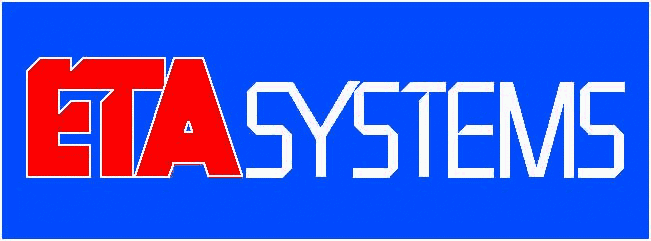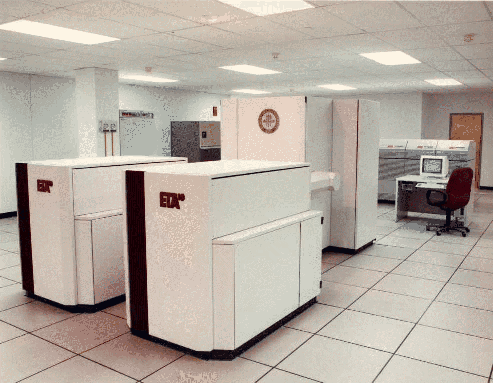

ETA systems, like Cray Research, was a spin-off from Control Data Corporation. Unlike Cray Research, however, ETA never escaped the orbit of its parent company, and was closed by CDC in April 1989 after having installed about 25 systems. The remaining inventory was given away to high schools!
The following data is second-hand, based on references in the literature and recollections of conversations with ETA veterans. As elsewhere in the DeadSuper pages, first-hand contributions would be preferred and greatly appreciated. Contact kevink@acm.org if you have any.
The ETA-10 was designed to be instruction-set compatible with the CDC Cyber 205. Like its ancestors in the CDC Cyber series, the ETA-10 was a vector machine without explicit vector registers, relying on pipelined memory operations to a high-bandwidth memory hierarchy. It was a shared-memory multiprocessor with up to 8 CPUs (and up to 18 I/O processors). The CPUs were capable of executing 4 double-precision or 8 single-precision operations per clock cycle.
Each CPU had up to 32M bytes of private memory, and the set of CPUs had common access to up to 2G bytes of shared memory. Most CPU load/store instructions could not touch the shared memory, however, and I/O operations could not touch the private memory, creating store-and-forward problems for the operating system. Fortunately, there were also interprocessor message buffers that lived outside the main memory space.
One of the innovations of ETA was the industrial use of chilled CMOS. Liquid nitrogen was used to cool the logic components to the point where an ~7ns cycle time was achieved - quite remarkable for the 1980s. A slower, lower-cost air-cooled version, the ETA-10P (code named "Piper") was also marketed.
At least two operating systems were developed for the ETA-10. One, EOS, was apparently dervived from the CDC VSOS system. The other was a UNIX SVR3 port.

Pictured here is the first ETA-10 shipped, to Florida State University.
Photographer unknown, scanned by Craig M. Carlson.
The "ETA Yearbook" is a collection of personal reminiscences of former ETA staff, compiled five years after the closure of the company. It's a large (255K) PostScript file, and is more personal than technical in content.